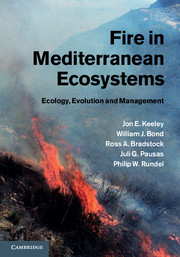Book contents
- Frontmatter
- Contents
- Section I Introduction
- Section II Regional patterns
- Section III Comparative Ecology, Evolution and Management
- 9 Fire-adaptive Trait Evolution
- 10 Fire and the Origins of Mediterranean-type Vegetation
- 11 Plant Diversity and Fire
- 12 Alien Species and Fire
- 13 Fire Management of Mediterranean Landscapes
- 14 Climate, Fire and Geology in the Convergence of Mediterranean-type Climate Ecosystems
- References
- Index
11 - Plant Diversity and Fire
from Section III - Comparative Ecology, Evolution and Management
Published online by Cambridge University Press: 05 January 2012
- Frontmatter
- Contents
- Section I Introduction
- Section II Regional patterns
- Section III Comparative Ecology, Evolution and Management
- 9 Fire-adaptive Trait Evolution
- 10 Fire and the Origins of Mediterranean-type Vegetation
- 11 Plant Diversity and Fire
- 12 Alien Species and Fire
- 13 Fire Management of Mediterranean Landscapes
- 14 Climate, Fire and Geology in the Convergence of Mediterranean-type Climate Ecosystems
- References
- Index
Summary
Mediterranean-type climate (MTC) regions are some of the most botanically diverse landscapes in the world (Table 11.1). They are among the 25 global hotspots of diversity in both richness of species and endemics (Myers et al. 2000). Occupying a bit more than 2% of the Earth's surface these landscapes hold 15–20% of the world's total vascular plants (Cowling et al. 1996; Rundel 2004). Between the five regions there is extraordinary variation in temporal and spatial patterns of vascular plant diversity and the relationship between fire and diversity is quite different across the five MTC ecosystems.
Differences between MTC regions are evident at many scales but one of the frequently noted differences is the regional species density or number of species per unit area. To put this in perspective we need to recognize that one of the commonly held generalizations about species diversity is that it increases with area (Fig. 11.1a,b). This species–area relationship is understandable since there are constraints on the number of individuals that can sustainably occupy a given area. Thus, as area increases, the probability of encountering more species increases. However, despite the observation that the number of species increases with increasing area is one of the few “laws” in ecology (Lomolino 2001), there are exceptions. Dissimilar environments often have very different species richness. Thus, this species–area relationship only approaches the status of a “law” when describing patterns in nested samples (Dunn & Loehl 1988); that is, samples of different size taken from within the boundaries of larger samples so that species from the smallest sample unit share environmental features with larger sample units (Box 11.1). There is no clearer demonstration of this than the species–area relationship observed for total regional diversity between the five MTC regions (Fig. 11.1c). The glaring lack of fit to an idealized species–area relationship (Fig. 11.1a) points up some of the important differences in diversity between these MTC regions. These patterns are the result of complex responses to subtle variations in climate, not so subtle variations in geology, and to their interaction with fire, as well as to phylogenetic and biogeographic histories.
- Type
- Chapter
- Information
- Fire in Mediterranean EcosystemsEcology, Evolution and Management, pp. 310 - 329Publisher: Cambridge University PressPrint publication year: 2011



